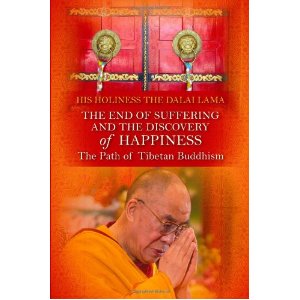 The End of Suffering and the Discovery of Happiness by His Holiness the Dalai Lama is the first book I’ve had the privilege of reviewing for Hay House. The first of the six chapters, drawn from various essays by His Holiness, is the frame for the rest. This chapter, “What Can Religion Contribute to Mankind,” addresses the fundamental human problem: the desire for happiness and the experience of suffering.
The End of Suffering and the Discovery of Happiness by His Holiness the Dalai Lama is the first book I’ve had the privilege of reviewing for Hay House. The first of the six chapters, drawn from various essays by His Holiness, is the frame for the rest. This chapter, “What Can Religion Contribute to Mankind,” addresses the fundamental human problem: the desire for happiness and the experience of suffering.
The Dalai Lama’s premise, with which I imagine most everyone reading this will agree, is that material development is not sufficient to solve the problem of suffering. What is lacking is development of consciousness or mind. And while we have developed substantial mental capacities, we have largely neglected the heart.
“Although the intellect—the “brain” aspect of human beings—has been much developed and put to use, we have somehow neglected the “heart” aspect, by which I mean the development of a good heart, love, compassion, kindness, and forgiveness….The key point is developing a basic human feeling, which means genuine sincerity, genuine openness, genuine love and kindness, and respect for others as brothers and sisters.”
After establishing that development of the mind and heart is essential if we are to heal the fundamental human problem, the Dalai Lama moves to personal responsibility. It is not enough to work for world peace, we must cultivate inner peace. It is not enough to advocate for justice, we must cultivate the qualities of clarity and compassion in ourselves.
The foundation of personal responsibility is practice, and that forms the basis of the rest of the book. Chapters two through six are somewhat heavy lifting. In them the Dalai Lama interprets and to some extent simplifies core teachings and practices of Tibetan Buddhism. Much of this material will be challenging for all but advanced practitioners.I found myself reading many passages two and three times before I felt I had some grasp of their meaning. The descriptions of advanced practices were understandable, but not immediately useful to someone who is not well along the path.
I thought several times of setting the book aside, and I’m glad I did not. By sticking to it, I developed a deeper appreciation of the commitment we must make to whatever practice we adopt if, in fact, we are to be the change we wish to see in the world. The book awoke in me a warrior energy, which continues to inspire me to spiritual action. Finally, I felt in some manner that I was spending time in the presence of this great being.
Bottom line: While it’s not a light read, The End of Suffering and the Discovery of Happiness is a window into the heart of Tibetan Buddhism and an invitation to hang out for a while with its spiritual leader. I’d read it again.

